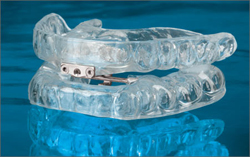
Snoring is a serious health condition that increases the risk of high blood pressure, stroke, cardiovascular disorders, heart failure, daytime fatigue, dementia, memory problems, obesity, diabetes and depression. Additionally, sleep apnea is a more serious sleep disorder characterized by abnormal pauses in breathing or instances of abnormally low breathing during sleep. Sleep apnea carries the very same risks as snoring. In fact, snoring can often be an indicator of sleep apnea, and once these conditions are treated, patients report an increase in memory, energy and vitality.
Sleep dentistry is a successful and viable option in the treatment of sleep disorders. We offer oral sleep appliances that aid in the opening of obstructed airways, and help to provide long awaited nights of much needed rest. Check out the details below and consider how you might benefit from sleep dentistry.
What Causes Snoring
Snoring occurs when air travels faster through a narrow tube than through a broad one. This rapidly moving air causes the relaxed soft tissues of the throat to vibrate. It is this vibration that creates the sound of snoring.
This narrowing of the upper airway can be due to large tonsils, a long uvula (the small piece of soft tissue that dangles from the soft palate over the back of the tongue) or excessive flabby tissue in the throat. However, the most common cause of narrowing of the upper airway is a tongue muscle that becomes too relaxed during sleep. When relaxed, the muscle is sucked into the back of the throat with each breath taken.
What is Sleep Apnea
Sleep apnea is a sleep disorder characterized by abnormal pauses in breathing that can last from a few seconds to minutes but can also manifest as instances of abnormally low breathing during sleep. This disorder is diagnosed with an overnight sleep test called a polysomnogram, or "sleep study." (Often, your insurance will cover the treatment of sleep disorders when properly diagnosed with a sleep study.)
Obstructive Sleep Apnea (OSA) occurs when the airway completely collapses, blocking airflow into the lungs. The Sleep Apnea Cycle – falling asleep, jaw relaxing, airway collapsing, unconsciously awakening with a gasp, falling back asleep – can repeat itself 50 or more times per hour during the night. By keeping the airway open, air travels more slowly, reducing throat vibrations and thus reducing or stopping snoring. One of the most effective ways to keep the airway open during sleep is by holding the tongue forward.
An individual with sleep apnea is rarely aware of having difficulty breathing, even upon awakening. Sleep apnea is recognized as a problem by others witnessing the individual during episodes or is suspected because of its effects on the body. Symptoms may be present for years (or decades) without identification, during which time the sufferer may become conditioned to the daytime sleepiness and fatigue associated with significant levels of sleep disturbance.
Sleep Appliances vs. CPAP
CPAP (continuous positive air pressure applied through a nasal mask) is considered the “gold standard” for treatment of obstructive sleep apnea (OSA). CPAP, when used as recommended by your physician or sleep therapist, will control obstructive sleep apnea 100% of the time. Many patients do all they can to utilize their CPAP unit as recommended, but there are circumstances with some who, despite everyone’s best efforts, cannot tolerate the CPAP unit.
Still there is hope. Oral appliance sleep apnea therapy, provided by dentists specifically trained in the use of these devices, can be an effective alternative to CPAP. Oral appliances, which resemble sports mouth guards are more readily tolerated than CPAP systems for many patients. Oral appliances can also be used as first-line treatment for primary snoring that is not associated with obstructive sleep apnea.
These appliances should be fitted by dentists specifically trained in oral appliance therapy and those experienced in treatment of temporomandibular joint and dental occlusion. Treatment with oral appliances should be followed on a regular basis and have follow up polysomnography (or sleep study). Dr. Boyett has received the proper training and certification from LVI (Las Vegas Institute for Advanced Dental Studies) to treat oral disorders such as TMJ/TMD, Snoring and Sleep Obstruction. The TAP device and the Aveo TSD are the oral appliances of choice here in our office.
 |
TAP
The Thornton Adjustable Positioner (TAP®) is a custom-made two piece adjustable appliance that is worn while sleeping. The trays of the appliance snap over the upper and lower teeth and hook together. The design is based on the same principle as cardiopulmonary resuscitation, CPR. The airway must be opened to allow air to pass through the throat. The TAP® holds the lower jaw in a forward position so that it does not shift nor fall open during the night. This prevents the airway from collapsing. The more you pull your jaw forward, the more your airway will open.
 |
Aveo TSD
The Aveo TSD (tongue stabilizing device) is a brilliantly simple, effective and noninvasive anti-snoring medical device. It provides an easy solution for the treatment of problem snoring. It is only available by dentist or medical doctor prescription. Traditional mandibular advancement devices indirectly move the tongue forward by moving the mandible. But aveoTSD gently suctions to the tip of the tongue, preventing it from falling back into the throat and obstructing the airway.
Leave a Reply